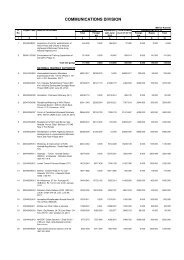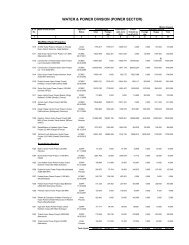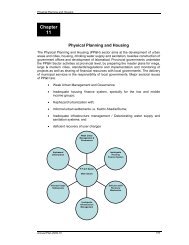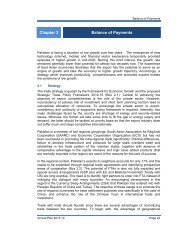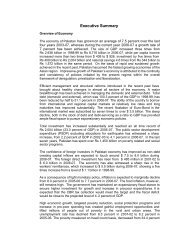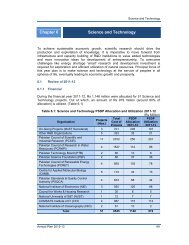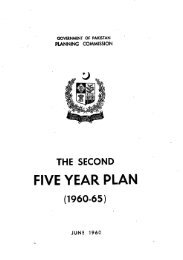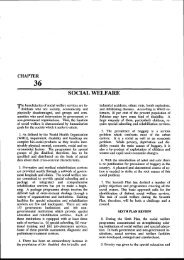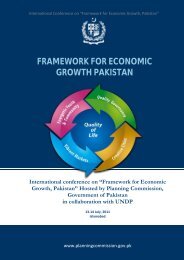Manual for Development Projects - Planning Commission
Manual for Development Projects - Planning Commission
Manual for Development Projects - Planning Commission
Create successful ePaper yourself
Turn your PDF publications into a flip-book with our unique Google optimized e-Paper software.
Chapter 5<br />
to implement all the projects. It, thus, satisfies a frequent request of the decision-makers that projects be ranked<br />
in the order in which they should be undertaken. It is suitable <strong>for</strong> use when there is incomplete knowledge of all<br />
the projects. At any given discount rate we cannot, with confidence, use the net present worth, or the internal rate<br />
of return, or the benefit-cost ratio as ranking measures; our criterion tells us only to accept all projects which need<br />
the selection criterion <strong>for</strong> those three measures. The net benefit-investment ratio is the only measure of the ones<br />
we have discussed that can be used with confidence to rank directly.<br />
Sensitivity Analysis (Treatment of Uncertainty)<br />
5.13 Several times when the project is under execution, certain things go wrong with the project with the result<br />
that the desired benefits cannot be achieved within the stipulated time frame. For example, the actual execution<br />
of the project is delayed or the cost exceeds the original estimated cost (cost over-run). In such cases, the results<br />
get fairly changed. Many times, the IRR and NPW thus get reduced or the BCR becomes negative from positive.<br />
In order to take care of this problem, while the projects are under preparation or under examination, certain<br />
assumptions are applied <strong>for</strong> testing the viability of the project. For example, it is at times assumed that there will<br />
be a cost over-run by, say, 25% or a reduction in revenues, say, by 10% or a delay in getting the benefits, say, by<br />
three years and so on. Keeping one or two or all such assumptions in view, the streams of costs and benefits are<br />
re-drawn and the figures of costs and benefits are discounted and the NPW, BCR and IRR are re-worked out.<br />
This gives a fairly good picture as to what will be the fate of the projects if such mishaps occur. For the sensitivity<br />
analysis, it is very essential to carry out such an exercise in projects where high financial stakes are involved.<br />
Choosing Between Mutually Exclusive Alternative <strong>Projects</strong><br />
5.14 The preferred discount measure of project worth <strong>for</strong> choosing between mutually exclusive projects is the net<br />
present worth. Direct comparison of IRR, BCR, NBIR can lead to an incorrect investment decision. This is so<br />
because undertaking a small, high - paying project may preclude generating more wealth through a moderately<br />
remunerative but larger alternative. Sometimes what may at first be posed as a pair of mutually exclusive projects<br />
can, instead, be seen as successive phases of development. Although NPW is the preferred criterion <strong>for</strong><br />
choosing between mutually exclusive alternatives, it is possible to manipulate the IRR to use it to choose between<br />
the mutually exclusive alternatives. The net benefit-investment ratio can be used to rank mutually exclusive<br />
projects only when the ratios of all the projects in the investment programme are known. There<strong>for</strong>e it is not a<br />
practical measure to use <strong>for</strong> this purpose. To use IRR <strong>for</strong> mutually exclusive project selection, the cash flow of the<br />
smaller alternative is subtracted year by year from the cash flow of the larger alternative. This stream of<br />
differences is then discounted to determine the internal rate of return of the stream. This is the financial or<br />
economic rate of return to the additional resources necessary to implement the larger alternative as opposed to<br />
the smaller one. This method is only applicable <strong>for</strong> a single pair of mutually exclusive projects.<br />
Domestic Resource Cost (Modified Bruno Ratio)<br />
Page 11 of 24<br />
5.15 In countries where there are balance of payments problems and where import substitution or export<br />
promotion is an important objective, it is useful to estimate the cost in domestic currency required to earn a unit of<br />
<strong>for</strong>eign exchange through a proposed project. It is not enough just to earn or save <strong>for</strong>eign exchange; some idea<br />
must be <strong>for</strong>med of the cost of saving <strong>for</strong>eign exchange and a judgement must be made about whether that cost is<br />
too high. By expressing the cost of earning or saving a unit of <strong>for</strong>eign exchange as domestic resource cost, a<br />
direct comparison may be made with the official exchange rate and various shadow prices <strong>for</strong> <strong>for</strong>eign exchange.<br />
To calculate the domestic resource cost by this method, it is necessary to know four items: (i) the <strong>for</strong>eign<br />
exchange value of the product to be produced, (ii) the <strong>for</strong>eign exchange cost incurred to produce the product (that<br />
is, the <strong>for</strong>eign exchange cost of such things as imported fuels, imported raw materials, and the like), (iii) the<br />
domestic currency cost of producing the output, and (iv) the opportunity cost of capital. The present worth of the<br />
net <strong>for</strong>eign exchange saving (discounted at the opportunity cost of capital) is compared with the present worth of<br />
the domestic cost of realizing these savings. The ratio between the two present worth is the domestic resource<br />
cost, and it may be directly compared with the official exchange rate or with shadow exchange rates. The<br />
Modified Bruno Ratio <strong>for</strong>mula is given below:<br />
http://hd2/pc/popup/ch5_p.html<br />
9/23/2010




